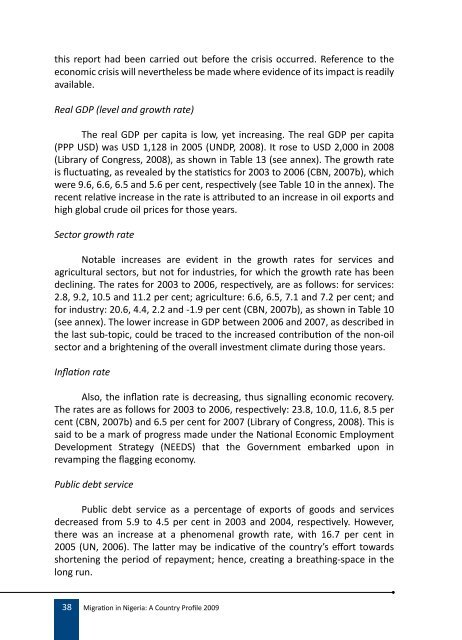Migration Profile on Nigeria - IOM Publications - International ...
Migration Profile on Nigeria - IOM Publications - International ...
Migration Profile on Nigeria - IOM Publications - International ...
You also want an ePaper? Increase the reach of your titles
YUMPU automatically turns print PDFs into web optimized ePapers that Google loves.
this report had been carried out before the crisis occurred. Reference to the<br />
ec<strong>on</strong>omic crisis will nevertheless be made where evidence of its impact is readily<br />
available.<br />
Real GDP (level and growth rate)<br />
The real GDP per capita is low, yet increasing. The real GDP per capita<br />
(PPP USD) was USD 1,128 in 2005 (UNDP, 2008). It rose to USD 2,000 in 2008<br />
(Library of C<strong>on</strong>gress, 2008), as shown in Table 13 (see annex). The growth rate<br />
is fluctuating, as revealed by the statistics for 2003 to 2006 (CBN, 2007b), which<br />
were 9.6, 6.6, 6.5 and 5.6 per cent, respectively (see Table 10 in the annex). The<br />
recent relative increase in the rate is attributed to an increase in oil exports and<br />
high global crude oil prices for those years.<br />
Sector growth rate<br />
Notable increases are evident in the growth rates for services and<br />
agricultural sectors, but not for industries, for which the growth rate has been<br />
declining. The rates for 2003 to 2006, respectively, are as follows: for services:<br />
2.8, 9.2, 10.5 and 11.2 per cent; agriculture: 6.6, 6.5, 7.1 and 7.2 per cent; and<br />
for industry: 20.6, 4.4, 2.2 and -1.9 per cent (CBN, 2007b), as shown in Table 10<br />
(see annex). The lower increase in GDP between 2006 and 2007, as described in<br />
the last sub-topic, could be traced to the increased c<strong>on</strong>tributi<strong>on</strong> of the n<strong>on</strong>-oil<br />
sector and a brightening of the overall investment climate during those years.<br />
Inflati<strong>on</strong> rate<br />
Also, the inflati<strong>on</strong> rate is decreasing, thus signalling ec<strong>on</strong>omic recovery.<br />
The rates are as follows for 2003 to 2006, respectively: 23.8, 10.0, 11.6, 8.5 per<br />
cent (CBN, 2007b) and 6.5 per cent for 2007 (Library of C<strong>on</strong>gress, 2008). This is<br />
said to be a mark of progress made under the Nati<strong>on</strong>al Ec<strong>on</strong>omic Employment<br />
Development Strategy (NEEDS) that the Government embarked up<strong>on</strong> in<br />
revamping the flagging ec<strong>on</strong>omy.<br />
Public debt service<br />
Public debt service as a percentage of exports of goods and services<br />
decreased from 5.9 to 4.5 per cent in 2003 and 2004, respectively. However,<br />
there was an increase at a phenomenal growth rate, with 16.7 per cent in<br />
2005 (UN, 2006). The latter may be indicative of the country’s effort towards<br />
shortening the period of repayment; hence, creating a breathing-space in the<br />
l<strong>on</strong>g run.<br />
38 <str<strong>on</strong>g>Migrati<strong>on</strong></str<strong>on</strong>g> in <strong>Nigeria</strong>: A Country <str<strong>on</strong>g>Profile</str<strong>on</strong>g> 2009

















